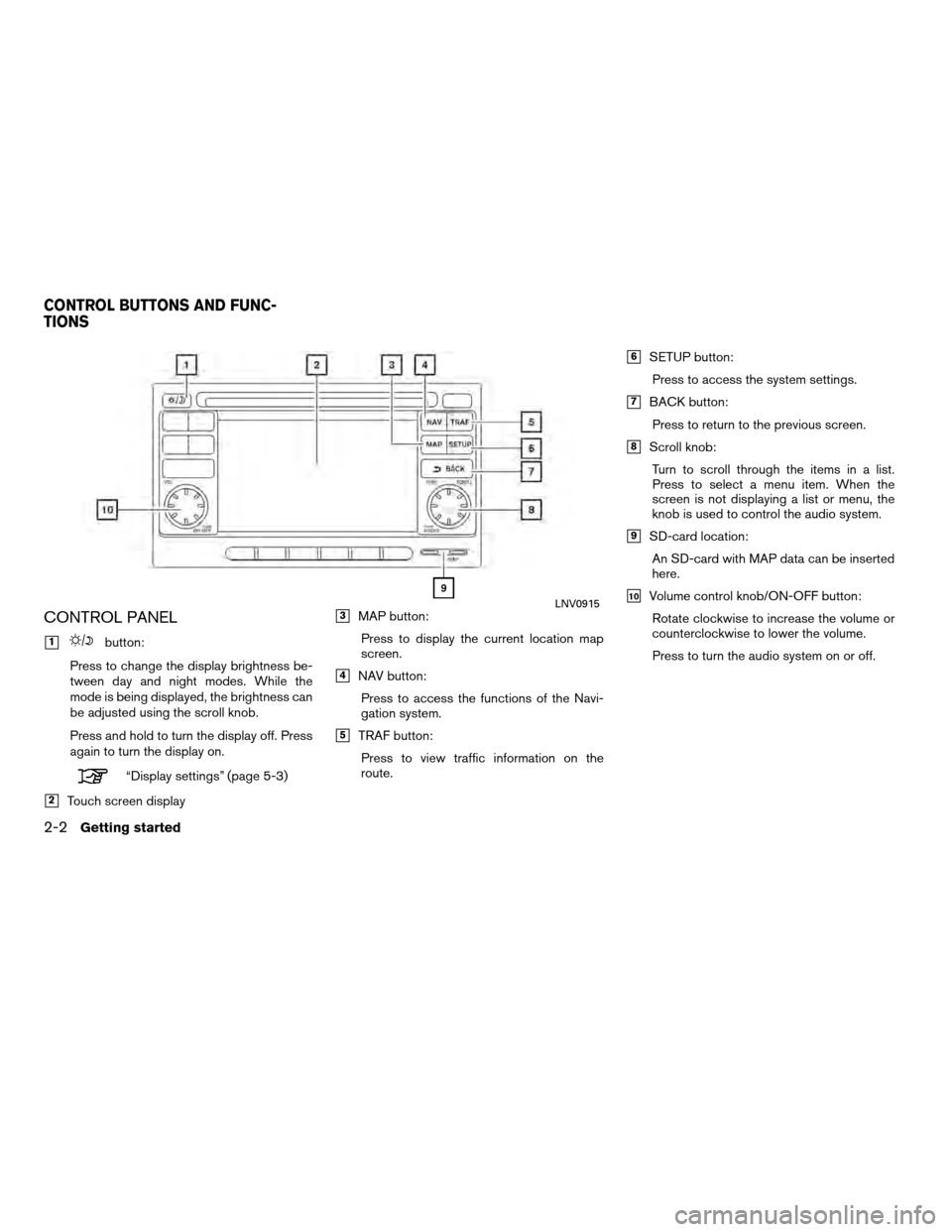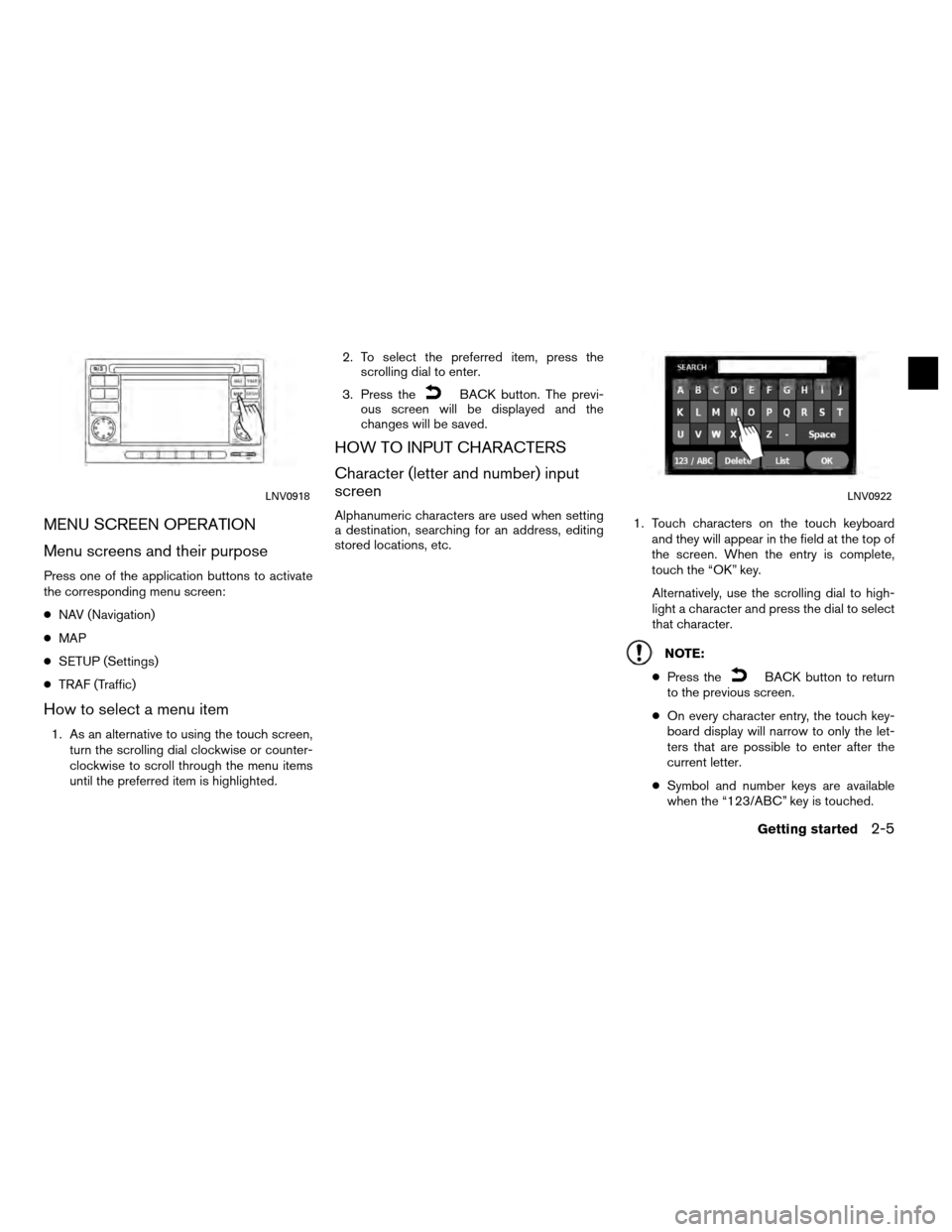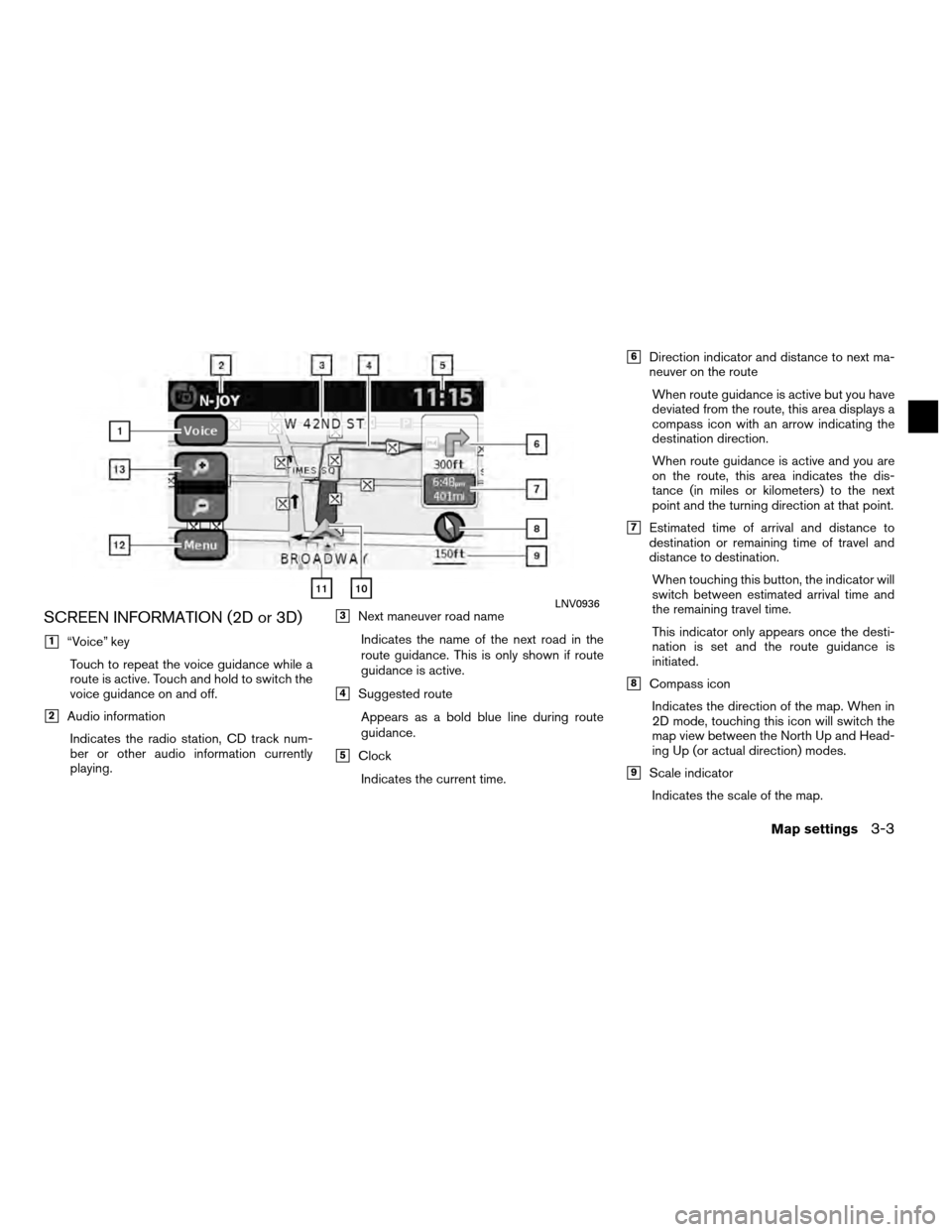Page 9 of 79

CONTROL PANEL
�1button:
Press to change the display brightness be-
tween day and night modes. While the
mode is being displayed, the brightness can
be adjusted using the scroll knob.
Press and hold to turn the display off. Press
again to turn the display on.
“Display settings” (page 5-3)
�2Touch screen display
�3MAP button: Press to display the current location map
screen.
�4NAV button:Press to access the functions of the Navi-
gation system.
�5TRAF button:Press to view traffic information on the
route.
�6SETUP button:Press to access the system settings.
�7BACK button:Press to return to the previous screen.
�8Scroll knob:Turn to scroll through the items in a list.
Press to select a menu item. When the
screen is not displaying a list or menu, the
knob is used to control the audio system.
�9SD-card location:An SD-card with MAP data can be inserted
here.
�10Volume control knob/ON-OFF button:Rotate clockwise to increase the volume or
counterclockwise to lower the volume.
Press to turn the audio system on or off.LNV0915
CONTROL BUTTONS AND FUNC-
TIONS
2-2Getting started
Page 10 of 79
STEERING WHEEL SWITCH
The volume control buttons on the steering
wheel
�1can be used to control the volume
level of the voice guidance given by the Naviga-
tion System. Press the + button to increase the
volume or the – button to decrease the volume
while the voice guidance is speaking. If the vol-
ume control buttons are pressed at any other
time, only the volume of the audio system is
adjusted.
The other steering wheel switches are used for
the audio system and Bluetooth� Hands-Free
Phone system and are not used to control the
Navigation System.
For more information about the audio system and
Bluetooth� Hands-Free Phone system, see the
vehicle’s Owner’s Manual.
TOUCH SCREEN OPERATION
The same operations described for the scrolling
dial are possible using touch screen operation.
VersaWNV0996SentraWNV0997
BASIC OPERATION
Getting started2-3
Page 11 of 79
Examples of touch screen operation
Selecting an item:
When any item is touched, the next screen is
displayed.Adjusting:
Touch the “+”, “-”, “>” or “<” key to adjust a
setting.
Scrolling through a message or list:
Touch the(up) or(down) keys on
the screen repeatedly to scroll through a mes-
sage or a list. When scrolling a lengthy list, you
can also touch the screen and slide your finger
along the scroll bar where shown to scroll more
quickly.
LNV0919LNV0920LNV0921
2-4Getting started
Page 12 of 79

MENU SCREEN OPERATION
Menu screens and their purpose
Press one of the application buttons to activate
the corresponding menu screen:
●NAV (Navigation)
● MAP
● SETUP (Settings)
● TRAF (Traffic)
How to select a menu item
1. As an alternative to using the touch screen,
turn the scrolling dial clockwise or counter-
clockwise to scroll through the menu items
until the preferred item is highlighted. 2. To select the preferred item, press the
scrolling dial to enter.
3. Press the
BACK button. The previ-
ous screen will be displayed and the
changes will be saved.
HOW TO INPUT CHARACTERS
Character (letter and number) input
screen
Alphanumeric characters are used when setting
a destination, searching for an address, editing
stored locations, etc. 1. Touch characters on the touch keyboard
and they will appear in the field at the top of
the screen. When the entry is complete,
touch the “OK” key.
Alternatively, use the scrolling dial to high-
light a character and press the dial to select
that character.
NOTE:
● Press the
BACK button to return
to the previous screen.
● On every character entry, the touch key-
board display will narrow to only the let-
ters that are possible to enter after the
current letter.
● Symbol and number keys are available
when the “123/ABC” key is touched.
LNV0918LNV0922
Getting started2-5
Page 13 of 79
●Touch the “123/ABC” key to toggle the
display between the touch keyboard for
letters and the touch keyboard for num-
bers and symbols.
2. To delete the last entry, touch the “Delete” key or hold it to delete all entries at once.
3. After finalizing the entries, touch the “List” or “OK” key for the completed list screen.
LNV0923
2-6Getting started
Page 14 of 79
3 Map settings
Map types........................................3-2
2-Dimensional (2D) view ........................3-2
3-Dimensional (3D) view ........................3-2
Screen information (2D or 3D) ...................3-3
Moving a map . . . ..................................3-4
Returning to the current vehicle location ...........3-4
Map options menu screen ..........................3-5
Changing the map scale . . . ........................3-5
Map scale . . . ..................................3-5 Looking at information on the map
...................3-6
Map symbols ...................................3-6
Map settings for the map screen ....................3-7
Map SD-card .....................................3-8
How to handle the SD-card ......................3-8
SD-card replacement . . . ........................3-9
How to order map data updates ..................3-9
About the map data .............................3-9
End-user terms ................................ 3-10
Page 15 of 79
2-DIMENSIONAL (2D) VIEW
The 2D map is a two-dimensional (flat) repre-
sentation of the map data, similar to a road map,
focused on the vehicle’s position (vehicle icon) .
“Screen information (2D or 3D)”
(page 3-3)
“Map settings for the map screen”
(page 3-7)
3-DIMENSIONAL (3D) VIEW
The 3D map displays the map from an elevated
perspective, providing a panoramic view over a
long distance.
The map in 3D view always appears with the cur-
rent forward direction facing up (heading up) .
“Screen information (2D or 3D)”
(page 3-3)
“Map settings for the map screen”
(page 3-7)
2DLNV09343DLNV0935
MAP TYPES
3-2Map settings
Page 16 of 79

SCREEN INFORMATION (2D or 3D)
�1“Voice” keyTouch to repeat the voice guidance while a
route is active. Touch and hold to switch the
voice guidance on and off.
�2Audio informationIndicates the radio station, CD track num-
ber or other audio information currently
playing.
�3Next maneuver road name
Indicates the name of the next road in the
route guidance. This is only shown if route
guidance is active.
�4Suggested routeAppears as a bold blue line during route
guidance.
�5ClockIndicates the current time.
�6Direction indicator and distance to next ma-
neuver on the route
When route guidance is active but you have
deviated from the route, this area displays a
compass icon with an arrow indicating the
destination direction.
When route guidance is active and you are
on the route, this area indicates the dis-
tance (in miles or kilometers) to the next
point and the turning direction at that point.
�7Estimated time of arrival and distance to
destination or remaining time of travel and
distance to destination.
When touching this button, the indicator will
switch between estimated arrival time and
the remaining travel time.
This indicator only appears once the desti-
nation is set and the route guidance is
initiated.
�8Compass iconIndicates the direction of the map. When in
2D mode, touching this icon will switch the
map view between the North Up and Head-
ing Up (or actual direction) modes.
�9Scale indicatorIndicates the scale of the map.
LNV0936
Map settings3-3